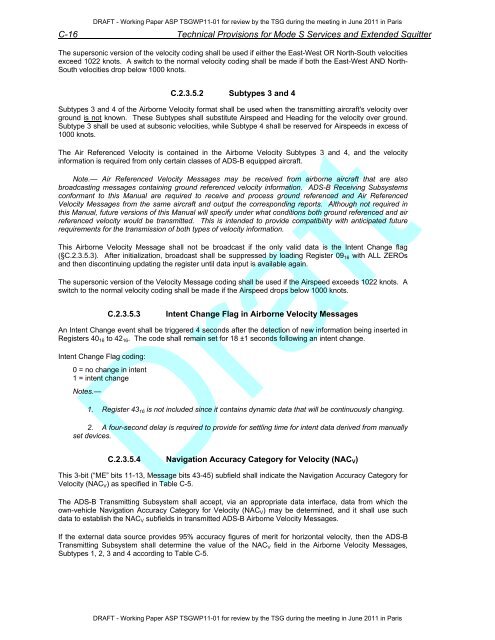Technical Provisions for Mode S Services and Extended Squitter
Technical Provisions for Mode S Services and Extended Squitter
Technical Provisions for Mode S Services and Extended Squitter
You also want an ePaper? Increase the reach of your titles
YUMPU automatically turns print PDFs into web optimized ePapers that Google loves.
DRAFT - Working Paper ASP TSGWP11-01 <strong>for</strong> review by the TSG during the meeting in June 2011 in Paris<br />
C-16 <strong>Technical</strong> <strong>Provisions</strong> <strong>for</strong> <strong>Mode</strong> S <strong>Services</strong> <strong>and</strong> <strong>Extended</strong> <strong>Squitter</strong><br />
The supersonic version of the velocity coding shall be used if either the East-West OR North-South velocities<br />
exceed 1022 knots. A switch to the normal velocity coding shall be made if both the East-West AND North-<br />
South velocities drop below 1000 knots.<br />
C.2.3.5.2 Subtypes 3 <strong>and</strong> 4<br />
Subtypes 3 <strong>and</strong> 4 of the Airborne Velocity <strong>for</strong>mat shall be used when the transmitting aircraft's velocity over<br />
ground is not known. These Subtypes shall substitute Airspeed <strong>and</strong> Heading <strong>for</strong> the velocity over ground.<br />
Subtype 3 shall be used at subsonic velocities, while Subtype 4 shall be reserved <strong>for</strong> Airspeeds in excess of<br />
1000 knots.<br />
The Air Referenced Velocity is contained in the Airborne Velocity Subtypes 3 <strong>and</strong> 4, <strong>and</strong> the velocity<br />
in<strong>for</strong>mation is required from only certain classes of ADS-B equipped aircraft.<br />
Note.— Air Referenced Velocity Messages may be received from airborne aircraft that are also<br />
broadcasting messages containing ground referenced velocity in<strong>for</strong>mation. ADS-B Receiving Subsystems<br />
con<strong>for</strong>mant to this Manual are required to receive <strong>and</strong> process ground referenced <strong>and</strong> Air Referenced<br />
Velocity Messages from the same aircraft <strong>and</strong> output the corresponding reports. Although not required in<br />
this Manual, future versions of this Manual will specify under what conditions both ground referenced <strong>and</strong> air<br />
referenced velocity would be transmitted. This is intended to provide compatibility with anticipated future<br />
requirements <strong>for</strong> the transmission of both types of velocity in<strong>for</strong>mation.<br />
This Airborne Velocity Message shall not be broadcast if the only valid data is the Intent Change flag<br />
(§C.2.3.5.3). After initialization, broadcast shall be suppressed by loading Register 0916 with ALL ZEROs<br />
<strong>and</strong> then discontinuing updating the register until data input is available again.<br />
The supersonic version of the Velocity Message coding shall be used if the Airspeed exceeds 1022 knots. A<br />
switch to the normal velocity coding shall be made if the Airspeed drops below 1000 knots.<br />
C.2.3.5.3 Intent Change Flag in Airborne Velocity Messages<br />
An Intent Change event shall be triggered 4 seconds after the detection of new in<strong>for</strong>mation being inserted in<br />
Registers 4016 to 4216. The code shall remain set <strong>for</strong> 18 ±1 seconds following an intent change.<br />
Intent Change Flag coding:<br />
0 = no change in intent<br />
1 = intent change<br />
Notes.—<br />
Draft<br />
1. Register 43 16 is not included since it contains dynamic data that will be continuously changing.<br />
2. A four-second delay is required to provide <strong>for</strong> settling time <strong>for</strong> intent data derived from manually<br />
set devices.<br />
C.2.3.5.4 Navigation Accuracy Category <strong>for</strong> Velocity (NACV)<br />
This 3-bit (“ME” bits 11-13, Message bits 43-45) subfield shall indicate the Navigation Accuracy Category <strong>for</strong><br />
Velocity (NACV) as specified in Table C-5.<br />
The ADS-B Transmitting Subsystem shall accept, via an appropriate data interface, data from which the<br />
own-vehicle Navigation Accuracy Category <strong>for</strong> Velocity (NACV) may be determined, <strong>and</strong> it shall use such<br />
data to establish the NACV subfields in transmitted ADS-B Airborne Velocity Messages.<br />
If the external data source provides 95% accuracy figures of merit <strong>for</strong> horizontal velocity, then the ADS-B<br />
Transmitting Subsystem shall determine the value of the NAC V field in the Airborne Velocity Messages,<br />
Subtypes 1, 2, 3 <strong>and</strong> 4 according to Table C-5.<br />
DRAFT - Working Paper ASP TSGWP11-01 <strong>for</strong> review by the TSG during the meeting in June 2011 in Paris
















